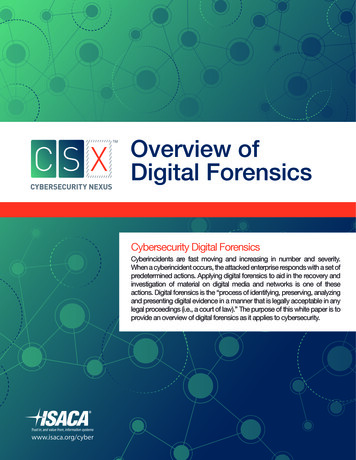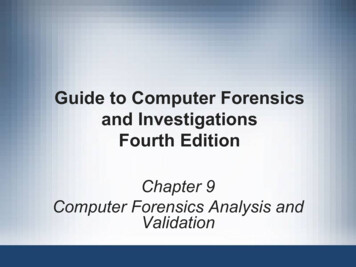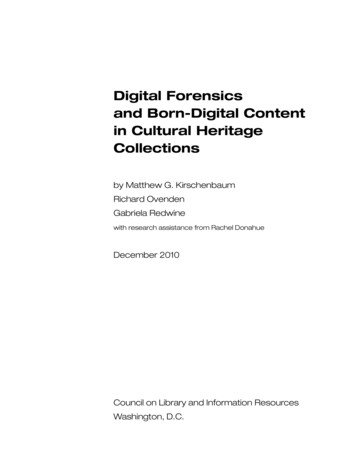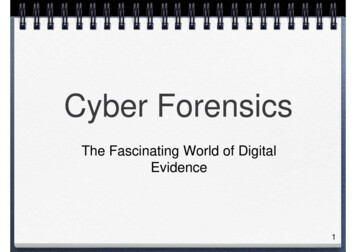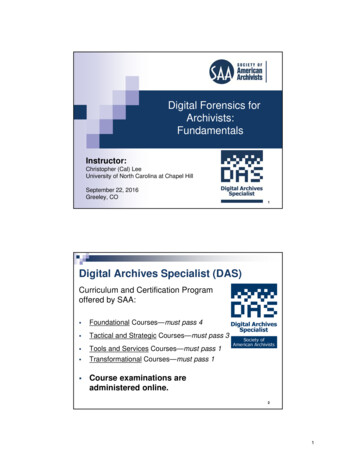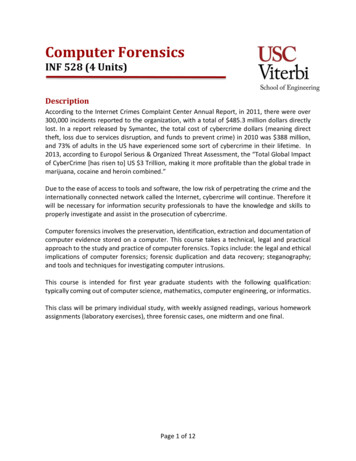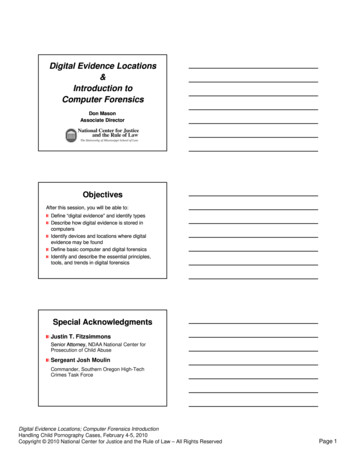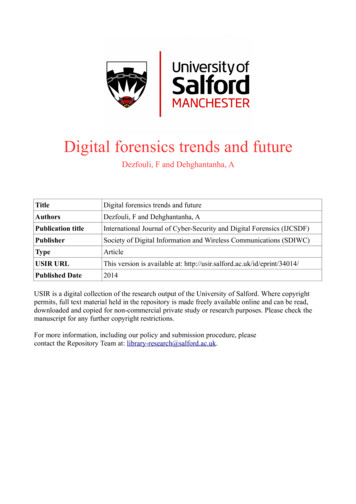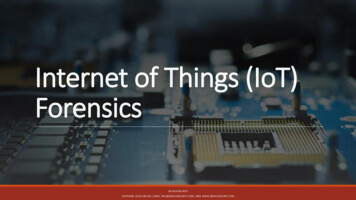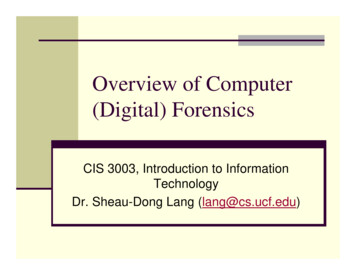
Transcription
Overview of Computer(Digital) ForensicsCIS 3003, Introduction to InformationTechnologyDr. Sheau-Dong Lang (lang@cs.ucf.edu)
What is Computer Forensics?Computer forensics is largely a response to a demand for servicefrom the law enforcement community [Noblett, Pollitt, andPresley]. The term "Computer Forensics" was coined in 1991 inthe first training session held by the International Association ofComputer Investigative Specialists (IACIS,http://www.cops.org) in Portland, Oregon [Marcella andGreenfield]. Computer forensics is “the application of scienceand engineering to the legal problem of digital evidence”[Sammes and Jenkinson]. Marcella, Albert J., Jr. and Greenfield, Robert S., Cyber Forensics: A Field Manualfor Collecting, Examining, and Preserving Evidence of Computer Crimes, SecondEdition, Chapter 17, Auerbach Publishers, 2002 Noblett, Michael G., Pollitt, Mark M., and Presley, Lawrence A., Recovering andExamining Computer Forensic Evidence, Forensic Science Communications,Volume 2, Number 4, US Department of Justice, October 2000 Sammes, T. and Jenkinson, B., Forensic Computing, Springer-Verlag, 2000
Roles of computer (or digital device) playedin digital crime investigations: as the instrument used in committing a crime (an intruder or acomputer virus writer using computers in illegal activities) as the victim (a comprised system, data stolen or deleted) as a container or storage warehouse for a crime (a cell phonethat has pictures of a stolen car, text messages with suspects) The Digital Evidence discipline became part of the AmericanSociety of Crime Laboratory Directors/LaboratoryAccreditation Board’s (ASCLD/LAB) accreditation program inApril 2003, see articles by John J. Barbara, Mark Pollitt, andCarrie Whitcomb discussing the efforts led by the SWGDE(Scientific Working Group on Digital Evidence) Formation of the new Digital and Multimedia Sciences Sectionof the American Academy of Forensic Sciences, 2/20/2008
Computer Crimes and Crime SceneInvestigation: As personal computers and access to the Internet become moreprevalent the modern society is increasingly dependent on thecomputer and networking technologies for storing, processing,and sharing data, and for email and message communication. The proliferation of computers has made computer-basedsystems and computer networks easy targets for criminalactivities. “Computer crimes were originally thought of just in the termsof hackers and virus makers, mainly due to the fact that at firstonly a few geeks had access to computers, but now anyone canpoint and click and use a computer to commit just about anycrime,” Sgt. Stenger , OCSO Computer Crime Squad
Computer (or digital) forensics involves thefollowing steps in handling of digital evidence: preservation (acquiring evidence without tampering, chain ofcustody, transport and storage, collecting data within legalconstraints) identification (labeling each item of evidence, bagging andtagging, identifying with case number, descriptions, date/timeof collection, signatures of handlers) extraction (authenticating evidence using hashes, using toolsand established procedures for data analysis, keyword searches,hex and graphics viewer, establishing timeline of events,corroborating evidence, who-what-when-where-why-how) documentation (actions taken during investigation, thefindings) interpretation (testifying and presentation in the court, as anexaminer or expert, see a recent news article)
Computer (Digital) forensics tools:Features provided to aid in forensic examination: Recover previously deleted files and folders Recognize disk partitions and common file systems(Windows FAT and NTFS, Linux ext2 and ext3, Unix UFS) Carve graphics and other files of known signatures fromunallocated disk clusters Search strings using regular expressions Review registry files (on Microsoft Windows systems) Recover user passwords Recover emails and instant messages (IMs) Provide timelines of file access activities based on date/timestamps Identify known files based on hash sets Identify artifacts specific to the operating system on disk
Host-based computer forensics vs. networkforensics: host-based forensics deals with personal or desktop devices,small enough to be taken down and imaged for analysis network forensics deals with servers, company databases,network devices such as routers, firewalls, intrusion detectionThree issues involved in computer forensics investigations: technical (the can-we issue): are there tools to extract thenecessary evidence, does the investigator have the expertiselegal (the may-we issue): is there violation of the 4thamendment of the US Constitution which guards againstunreasonable search and seizure, digital wiretapping ethical (the should-we issue): ethical concerns relating to theuse of computer forensics include proper use of prosecutorialand police discretion (see “Computer forensics: admissibilityof evidence in criminal cases” by Jerry Wegman)
Email and IM investigations: find email artifacts in client-based email (e.g., Outlook’s PSTfiles, Outlook Express DBX files) and web-based email(Yahoo, Hotmail) use FTK or open-source tools libPST (for Outlook),Eindeutig (for Outlook Express), AOL clients (for AOLemail) to reconstruct emails apply string searches (grep) to filter relevant emails andinstant messages (IMs) track email origins (reading email header information)
Windows Registry Files: identify installed applications (date/time, configurations,deleted applications) identify installed malicious code (compromised systems withvirus, rootkit, spyware programs) identify “most recently used” documents to understand recentactivities on a computer identify USB devices connected to the computer use FTK registry viewer (or regedit) to view registry files
Internet Web-browsing Activity: Internet Explorer (IE) uses history, cookies, and temporaryInternet Files (i.e. Internet cache) to save web activities use FTK or open-source tools pasco and galleta to viewbrowsing activities (both pasco and galleta are available athttp://sourceforge.net/docman/?group id 78332) use Paraben’s Netanalysis (commercial tool) for Internetcache, history, cookies, even in unallocated clusters two articles written by Keith J. Jones and Rohyt Belani aboutweb browser forensics (for IE and Mozilla/Firefox historyand cache files) arehttp://www.securityfocus.com/infocus/1827 andhttp://www.securityfocus.com/infocus/1832
Live system forensics and incident response: extract information about running applications (processes),open files, network connections, data contained in RAM server machines that cannot be shut down or have too muchdata requiring filtering from live system real time forensic analysis on remote systems (e.g., EnCaseEnterprise edition) in corporate environments open-source tools Helix and FIRE provide support for livesystem forensics freeware tools that monitor processes, file and diskoperations, and registry activities in real time, available b545027.aspx two articles (1, 2) on forensic analysis of live Linux systems
Static and dynamic analysis of unknownexecutables: malicious codes such as virus, rootkit, spyware areexecutable (binary) files string searches of executables may reveal minimuminformation regarding the code’s functionality a disassembler such as OllyDbg features an intuitive userinterface, advanced code analysis capable of recognizingprocedures, loops, API calls, switches, tables, constants andstrings, an ability to attach to a running program, and goodmulti-thread support. a disassembler and debugger such as IDA Pro providescontrolled execution and debugging of executables allowinguser interactions and analysis of runtime behaviors
Data Analysis: Forensic examiners typically are given somebackground information from the investigator(case agent) – things like names, addresses, timewindow, types of files (spreadsheets, pictures,movies), installed applications -- that will aid theexamination phase. Experienced examiners know where (files, folders,Windows registry) to look for relevant evidence,how to corroborate evidences, and how to get themost out of forensic tools.
AccessData’s FTK:Item CategoryViewerFile ListThe initial screen (Overview tab selected) for an open case in FTK
AccessData’s FTK (cont’d):ThumbnailViewerViewer forSelected FileViewer forSelected FileViewer forSelected FileGraphics tab selected for an open case in FTK
AccessData’s FTK (cont’d):Enter search termSearch ResultsViewer of the search hitsFile ListSearch results in FTK
AccessData’s FTK (cont’d):FTK Email Viewer
AccessData’s FTK (cont’d):FTK Cookie Viewer
Other Forensics Tools:Table paneTree paneView paneFilter paneGuidance Software’s EnCase
Other Forensics Tools (cont’d):File ListViewer forselected fileTSK/Autopsy’s Interface for File Analysis
Helix live system analysis:Helix initial screen
Helix live system analysis (cont’d):Built-in tools on Helix CD
Using Helix to image disk:Helix uses dd (data dump) to duplicate disks (seeexplanation of the command syntax and options athttp://www.softpanorama.org/Tools/dd.shtml)
Using helix to image a floppy disk(cont’d):
Audit.log file after dd is complete:
Forensics Software Tools: Guidance Software's EnCase (commercial, requires license dongle)Access Data Forensic Toolkit (commercial, runs in demomode without license dongle)Penguin Sleuth (knock-off of Knoppix with extra forensictools)Helix (another knock-off): booting from Penguin Sleuth orHelix will boot all drives Read-Only, boots into Linux inRAM (with more than 128MB of RAM)The Sleuth Kit consists of command-line tools and abrowser-like front-end AutopsySpada (Law Enforcement only, also a knock-off)AccessData’s FTK Imager (does not require license dongle)
Forensics Software Tools (cont’d): Norton Utilities/SystemWorks (DiskEdit is the primary one)* Unerase - in 2003 and earlier* Unformat - in 2003 and earlier* gDisk - in 2003 and earlier WhatFormat, FileAlyzer: tools to analyze files Quick View Plus: views many different file types (readonly) WinHex: Computer Forensics & Data Recovery Software,Hex Editor & Disk Editor A Microsoft article on Fundamental Computer InvestigationGuide For Windows, Jan. 11, 2007 National Institute of Justice’s Electronic Crime SceneInvestigation: A Guide for First Responders, Second Edition,April 14, 2008
Forensic Report:FTK’s Case Report
Careers in Computer Forensics: An article on computer forensics careers available athttp://About.com under careers tech careers computer jobs Monster.com’s career advices on computer forensics Careers in the U.S. Government, at http://www.usajobs.gov/entering keywords “computer forensic” Search http://www.careerbuilder.com/ entering keywords“computer forensics”It is a tough job to be a computer forensics expert: “In view ofthe above I find that the defendants have not met their burden of showing by apreponderance of the evidence that Moshlak's methodologies are reliable underFederal Rule of Evidence 702, or would otherwise assist the jury to understandthe evidence or to determine a fact in issue. Therefore, it is my recommendationthat plaintiff's motion to exclude Moshlak as an expert witness at trial beGRANTED.” in United States District Court, D. Puerto Rico, Nilda RIVERACRUZ, Plaintiff, v. LATIMER, BIAGGI, RACHID & GODREAU, LLP, et al.,Defendants,.Civil No. 04-2377 (ADC). June 16, 2008.
The Defendants' expert witness Mr. Steven Moshlakcontacted me via email on 11/29/2008 and gave the followingresponse to the ruling of the Daubert Hearing:"After reading Chief Magistrate-Judge's R&R (Report andRecommendation), it was quite contrary to the testimony andexhibits that were presented at the Daubert Hearing. Although theUS District Judge assigned to this case relied upon the Magistrate'sR&R, she never saw the testimony and the attorneys for thedefense should have aggressively pursued the misinformation. Nomention of the alteration of the data contained on the hard drive,while in the custody of the Plaintiff's Counsel's Expert, was noted inthe R&R, which can impact the credibility of the Plaintiff's case, norwas the testimony cited that the basis for the CF methodologyemployed is based upon US Department of Justice computerforensics methodologies.In essence the attorney is responsible for being an advocate of theclient and the interface with the court, not the CF person. Thus, theCF person was essentially left "hung-out to dry," due to thesystems and circumstances beyond the control of the CF person inthis case."
Greenfield]. Computer forensics is “the application of science and engineering to the legal problem of digital evidence” [Sammes and Jenkinson]. What is Computer Forensics? Marcella, Albert J., Jr. and Greenfield, Robert S., Cyber Forensics: A Field Manual for Collecting, Exam
